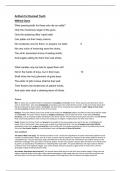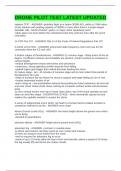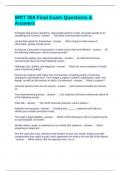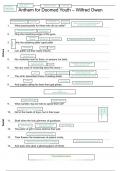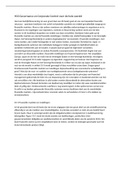New methods to assessing pain
Letti ng go of structure
Name:
Student number:
Date: 02/12/21
Group: 1
Tutor: Nienke van Pijkeren
Number of words: 2142
, Introduction
Pain assessment is a very common and regular thing in hospitals, if pain is not adequately
assessed and treated it can delay recovery and possibly even extent hospital stay (Ista et al.,
2013). Hospitals have tried to improve their pain management in a number of different
ways, including education about pain to both staff and patient, formal audit, feedback and
computerized reminders (Haller et al., 2011). Right now, there seems to be consensus that
good pain treatment consists of regular assessment and reassessment of a patient’s pain and
that there should be clear protocols or guidelines (Carlson, 2010). Aside from the fact that
the efficacy of this method is questionable, it is also a burden on nurses and other health
professionals. That’s why, based on the experiences with existing protocols, a top clinical
hospital in the Netherlands, Spaarne Gasthuis, recently implemented a new pain assessment
method. Instead of completing a pain scale form three times a day the nurses check whether
a patient is actually in pain or not and if something can and should be done about it (KMPG,
2020). It other words, instead of increasing structures and protocols for pain management
they reduced them and made the context more important. This method is not widely used
and there is not much information available about the implementation and the efficiency.
What happens when a context that is usually full of structures and guidelines let’s go of
these guidelines? Will it reduce the burden on healthcare professionals, or will it only create
chaos and uncertainty? There is not much known about reducing structures in pain
management, that’s why this essay will try to answer the following question:
“How can pain be adequately assessed while letting go of formal structures and
instruments?”
Conceptual framework
Implementing a new evidence-based policy in healthcare organizations proves to be difficult
sometimes. The change principles often fail to be translated into organizational practice or
policy because of a mismatch (Harlos et al., 2012).
Dixon-Woods et al. (2011) also talk about the difficulties in their article about ex-post
theory. They state that you can’t copy paste an intervention that worked at a different
organization. In order to make it work you need a thorough understanding of how and why
the intervention works, that way you know if it can be used in your organizational structure
or if it possibly needs altering. To understand, there needs to be evaluation both after the as
well as during the implementation of the intervention. Evaluating during the implementation
is seen as the most important part and will give a clear view of the successes and delays of
the innovation and will provide the best opportunity to learn. It is critical to update the
intervention after it has been carried out, this can be done by combining the experience of
the program leader and the expertise of the social scientists (Dixon-Woods et al., 2011).
Bromley & Powell (2012) describe something similar regarding to policy. They talk
about decoupling, a mismatch between new policy and current practice. They state that to
prevent this, the daily practice should be kept in mind when making the new policy. The
authors describe two different kinds of decoupling, policy-practice and means-end
decoupling. Policy-practice decoupling occurs when there is a gap, there is no connection
between the new policy and the actual daily practice. This includes policies that are
implemented just to satisfy external factors but also policies that are not evaluated and
monitored enough so don’t make a change. In means-end decoupling however, the policy is
implemented thoroughly but the relationship to the desired outcome is too weak. They state
Letti ng go of structure
Name:
Student number:
Date: 02/12/21
Group: 1
Tutor: Nienke van Pijkeren
Number of words: 2142
, Introduction
Pain assessment is a very common and regular thing in hospitals, if pain is not adequately
assessed and treated it can delay recovery and possibly even extent hospital stay (Ista et al.,
2013). Hospitals have tried to improve their pain management in a number of different
ways, including education about pain to both staff and patient, formal audit, feedback and
computerized reminders (Haller et al., 2011). Right now, there seems to be consensus that
good pain treatment consists of regular assessment and reassessment of a patient’s pain and
that there should be clear protocols or guidelines (Carlson, 2010). Aside from the fact that
the efficacy of this method is questionable, it is also a burden on nurses and other health
professionals. That’s why, based on the experiences with existing protocols, a top clinical
hospital in the Netherlands, Spaarne Gasthuis, recently implemented a new pain assessment
method. Instead of completing a pain scale form three times a day the nurses check whether
a patient is actually in pain or not and if something can and should be done about it (KMPG,
2020). It other words, instead of increasing structures and protocols for pain management
they reduced them and made the context more important. This method is not widely used
and there is not much information available about the implementation and the efficiency.
What happens when a context that is usually full of structures and guidelines let’s go of
these guidelines? Will it reduce the burden on healthcare professionals, or will it only create
chaos and uncertainty? There is not much known about reducing structures in pain
management, that’s why this essay will try to answer the following question:
“How can pain be adequately assessed while letting go of formal structures and
instruments?”
Conceptual framework
Implementing a new evidence-based policy in healthcare organizations proves to be difficult
sometimes. The change principles often fail to be translated into organizational practice or
policy because of a mismatch (Harlos et al., 2012).
Dixon-Woods et al. (2011) also talk about the difficulties in their article about ex-post
theory. They state that you can’t copy paste an intervention that worked at a different
organization. In order to make it work you need a thorough understanding of how and why
the intervention works, that way you know if it can be used in your organizational structure
or if it possibly needs altering. To understand, there needs to be evaluation both after the as
well as during the implementation of the intervention. Evaluating during the implementation
is seen as the most important part and will give a clear view of the successes and delays of
the innovation and will provide the best opportunity to learn. It is critical to update the
intervention after it has been carried out, this can be done by combining the experience of
the program leader and the expertise of the social scientists (Dixon-Woods et al., 2011).
Bromley & Powell (2012) describe something similar regarding to policy. They talk
about decoupling, a mismatch between new policy and current practice. They state that to
prevent this, the daily practice should be kept in mind when making the new policy. The
authors describe two different kinds of decoupling, policy-practice and means-end
decoupling. Policy-practice decoupling occurs when there is a gap, there is no connection
between the new policy and the actual daily practice. This includes policies that are
implemented just to satisfy external factors but also policies that are not evaluated and
monitored enough so don’t make a change. In means-end decoupling however, the policy is
implemented thoroughly but the relationship to the desired outcome is too weak. They state



